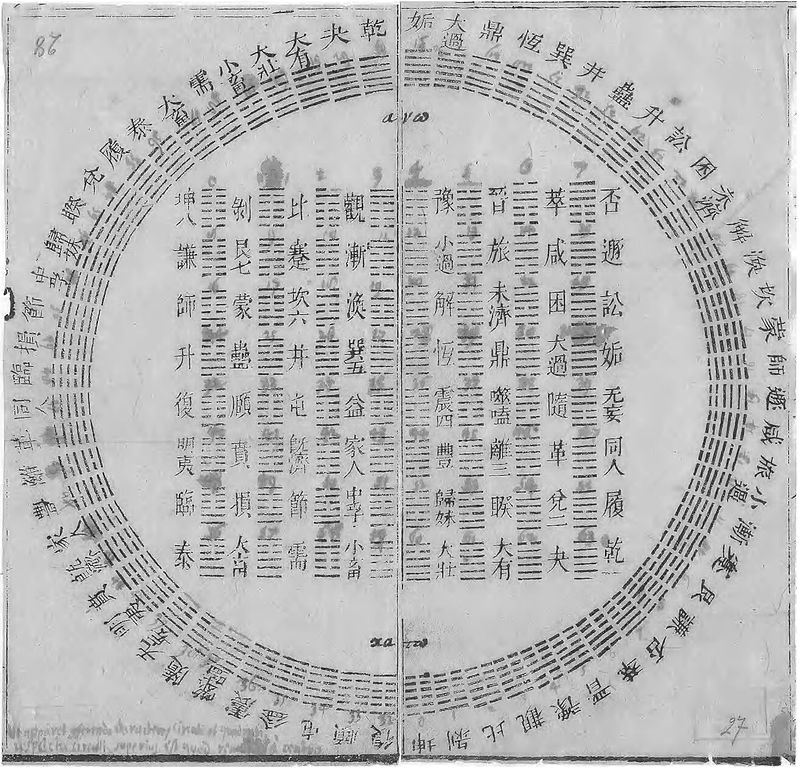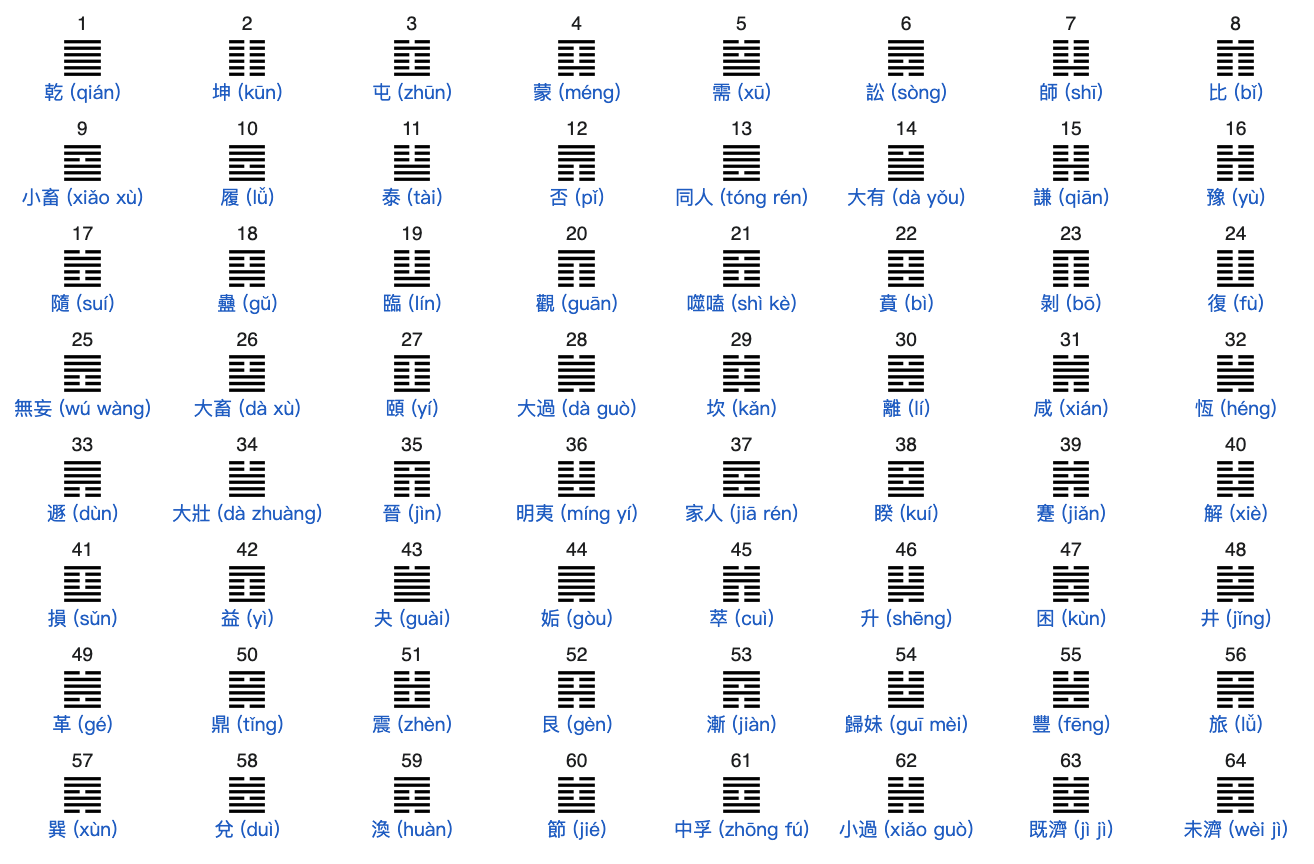I Ching
The I Ching or Yi Jing, usually translated Book of Changes or Classic of Changes, is an ancient Chinese divination text that is among the oldest of the Chinese classics. Originally a divination manual in the Western Zhou period (1000–750 BC), the I Ching was transformed over the course of the Warring States and early imperial periods (500–200 BC) into a cosmological text with a series of philosophical commentaries known as the "Ten Wings." After becoming part of the Five Classics in the 2nd century BC, the I Ching was the subject of scholarly commentary and the basis for divination practice for centuries across the Far East, and eventually took on an influential role in Western understanding of East Asian philosophical thought.
As a divination text, the I Ching is used for a traditional Chinese form of cleromancy known as I Ching divination, in which bundles of yarrow stalks are manipulated to produce sets of six apparently random numbers ranging from 6 to 9. Each of the 64 possible sets corresponds to a hexagram, which can be looked up in the I Ching. The hexagrams are arranged in an order known as the King Wen sequence. The interpretation of the readings found in the I Ching has been endlessly discussed and debated over the centuries.
History
The core of the I Ching is a Western Zhou divination text called the Changes of Zhou (Chinese: 周易; pinyin: Zhōu yì). Various modern scholars suggest dates ranging between the 10th and 4th centuries BC for the assembly of the text in approximately its current form. Based on a comparison of the language of the Zhou yi with dated bronze inscriptions, the American sinologist Edward Shaughnessy dated its compilation in its current form to the last quarter of the 9th century BC, during the early decades of the reign of King Xuan of Zhou (r. c. 827 – 782 BC). A copy of the text in the Shanghai Museum corpus of bamboo and wooden slips (discovered in 1994) shows that the Zhou yi was used throughout all levels of Chinese society in its current form by 300 BC, but still contained small variations as late as the Warring States period (c. 475–221 BC).
The name Zhou yi literally means the "changes" (易; Yì) of the Zhou dynasty. The "changes" involved have been interpreted as the transformations of hexagrams, of their lines, or of the numbers obtained from the divination.[8] Feng Youlan proposed that the word for "changes" originally meant "easy," as in a form of divination easier than the oracle bones, but there is little evidence for this.
Structure
The basic unit of the Zhou yi is the hexagram (卦 guà), a figure composed of six stacked horizontal lines (爻 yáo). Each line is either broken or unbroken. The received text of the Zhou yi contains all 64 possible hexagrams, along with the hexagram's name (卦名 guàmíng), a short hexagram statement (彖 tuàn), and six line statements (爻辭 yáocí). The statements were used to determine the results of divination, but the reasons for having two different methods of reading the hexagram are not known, and it is not known why hexagram statements would be read over line statements or vice versa.
The book opens with the first hexagram statement, yuán hēng lì zhēn (Chinese: 元亨利貞). These four words, translated traditionally by James Legge as "originating and penetrating, advantageous and firm," are often repeated in the hexagram statements and were already considered an important part of I Ching interpretation in the 6th century BC. Edward Shaughnessy describes this statement as affirming an "initial receipt" of an offering, "beneficial" for further "divining." The word zhēn (貞, ancient form 貞-oracle-alt.svg) was also used for the verb "divine" in the oracle bones of the late Shang dynasty, which preceded the Zhou. It also carried meanings of being or making upright or correct, and was defined by the Eastern Han scholar Zheng Xuan as "to enquire into the correctness" of a proposed activity.
The names of the hexagrams are usually words that appear in their respective line statements, but in five cases (2, 9, 26, 61, and 63) an unrelated character of unclear purpose appears. The hexagram names could have been chosen arbitrarily from the line statements, but it is also possible that the line statements were derived from the hexagram names. The line statements, which make up most of the book, are exceedingly cryptic. Each line begins with a word indicating the line number, "base, 2, 3, 4, 5, top", and either the number 6 for a broken line, or the number 9 for a whole line. Hexagrams 1 and 2 have an extra line statement, named yong. Following the line number, the line statements may make oracular or prognostic statements. Some line statements also contain poetry or references to historical events.
Hexagrams
In the canonical I Ching, the hexagrams are arranged in an order dubbed the King Wen sequence after King Wen of Zhou, who founded the Zhou dynasty and supposedly reformed the method of interpretation. The sequence generally pairs hexagrams with their upside-down equivalents, although in eight cases hexagrams are paired with their inversion.
Another order, found at Mawangdui in 1973, arranges the hexagrams into eight groups sharing the same upper trigram. But the oldest known manuscript, found in 1987 and now held by the Shanghai Library, was almost certainly arranged in the King Wen sequence, and it has even been proposed that a pottery paddle from the Western Zhou period contains four hexagrams in the King Wen sequence. Whichever of these arrangements is older, it is not evident that the order of the hexagrams was of interest to the original authors of the Zhou yi. The assignment of numbers, binary or decimal, to specific hexagrams, is a modern invention.
Yin and yang are represented by broken and solid lines: yin is broken (⚋) and yang is solid (⚊). Different constructions of three yin and yang lines lead to eight trigrams (八卦) namely, Qian (乾, ☰), Dui (兌, ☱), Li (離, ☲), Zhen (震, ☳), Xun (巽, ☴), Kan (坎, ☵), Gen (艮, ☶), and Kun (坤, ☷).
The different combinations of the two trigrams lead to 64 hexagrams.
The following table numbers the hexagrams in King Wen order:
Modern legacy
After the Xinhai Revolution of 1911, the I Ching lost its significance in political philosophy, but it maintained cultural influence as one of China's most ancient texts. Chinese writers offered parallels between the I Ching and subjects such as linear algebra and logic in computer science, aiming to demonstrate that ancient Chinese cosmology had anticipated Western discoveries. The Sinologist Joseph Needham took the opposite opinion, arguing that the I Ching had actually impeded scientific development by incorporating all physical knowledge into its metaphysics. However with the advent of quantum mechanics, physicist Niels Bohr credited inspiration from the Yin and Yang symbolisms in using intuition to interpret the new field, which disproved principles from older Western classical mechanics. The principle of complementarity heavily used concepts from the I Ching as mentioned in his writings.
The psychologist Carl Jung took interest in the possible universal nature of the imagery of the I Ching, and he introduced an influential German translation by Richard Wilhelm by discussing his theories of archetypes and synchronicity. Jung wrote, "Even to the most biased eye, it is obvious that this book represents one long admonition to careful scrutiny of one's own character, attitude, and motives." The book had a notable impact on the 1960s counterculture and on 20th century cultural figures such as Philip K. Dick, John Cage, Jorge Luis Borges, Terence McKenna and Hermann Hesse. Joni Mitchell references the six yang hexagram in her song "Amelia" from her "Hejira" album after she describes the image of "...six jet planes leaving six white vapor trails across the bleak terrain...."It also inspired the 1968 song While My Guitar Gently Weeps by The Beatles.
The modern period also brought a new level of skepticism and rigor to I Ching scholarship. Li Jingchi spent several decades producing a new interpretation of the text, which was published posthumously in 1978. Modern data scientists including Alex Liu proposed to represent and develop I Ching methods with data science 4E framework and latent variable approaches for a more rigorous representation and interpretation of I Ching. Gao Heng, an expert in pre-Qin China, reinvestigated its use as a Zhou dynasty oracle. Edward Shaughnessy proposed a new dating for the various strata of the text. New archaeological discoveries have enabled a deeper level of insight into how the text was used in the centuries before the Qin dynasty. Proponents of newly reconstructed Western Zhou readings, which often differ greatly from traditional readings of the text, are sometimes called the "modernist school."

